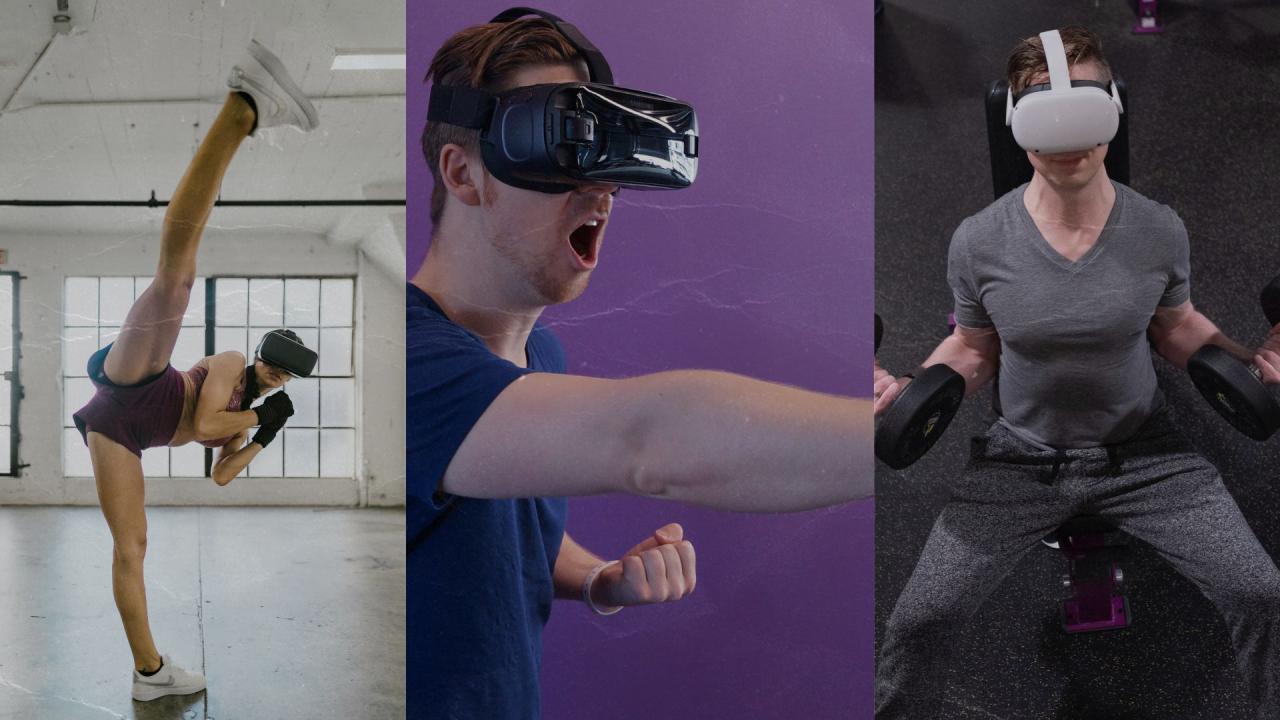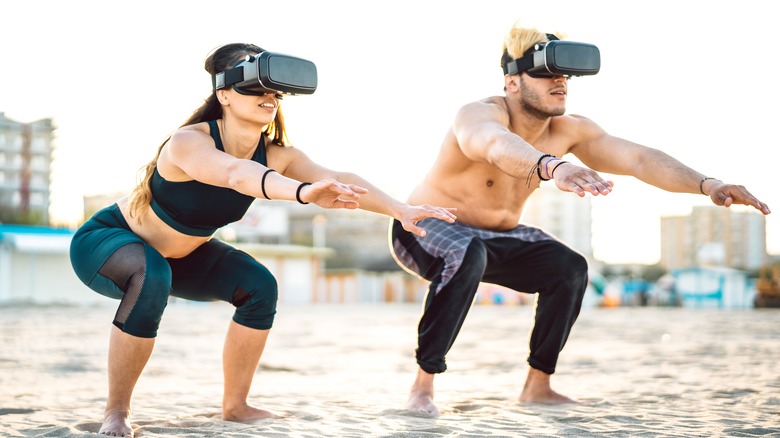Exploring the world of Virtual Reality Workouts for a Fit Lifestyle opens up a realm of possibilities for fitness enthusiasts. This captivating introduction delves into the benefits, types, technology, and safety considerations of incorporating virtual reality into your exercise routine.
From boosting motivation to creating a sense of community, virtual reality workouts offer a unique and engaging way to stay fit and active.
Benefits of Virtual Reality Workouts
Virtual reality workouts offer a unique set of benefits that can greatly enhance the overall fitness experience.
Enhanced Motivation
Virtual reality workouts provide an immersive and interactive environment that can significantly boost motivation levels. The engaging nature of VR technology can make exercise more enjoyable and appealing, encouraging individuals to stay consistent with their workout routine.
Increased Engagement
Through immersive experiences and interactive elements, virtual reality workouts have the potential to increase engagement levels during exercise sessions. The ability to explore different virtual environments and scenarios can make workouts more engaging and exciting, ultimately leading to better adherence to fitness goals.
Improved Enjoyment and Adherence
Virtual reality can transform traditional workouts into fun and enjoyable experiences. By incorporating gamification elements and interactive challenges, VR workouts can make exercise more entertaining and appealing to a wider audience. This increased enjoyment can lead to higher adherence rates, as individuals are more likely to stick to a workout routine that they find engaging and fulfilling.
Types of Virtual Reality Workouts
Virtual reality workouts offer a wide range of options for users to engage in physical activity in an immersive and interactive way. Let's explore some examples of virtual reality workout programs and the variety of workout genres available in the virtual reality space.
Example Virtual Reality Workout Programs
- Beat Saber: A popular rhythm-based game where players slash blocks to the beat of the music, providing a full-body workout while having fun.
- BoxVR: Combines boxing techniques with rhythm gameplay to deliver a high-intensity cardio workout.
- Supernatural: A subscription-based fitness app that offers daily workouts set in breathtaking virtual environments.
Workout Genres in Virtual Reality
- Cardio: Many virtual reality workout programs focus on cardio exercises such as dancing, boxing, and running to improve cardiovascular health.
- Strength Training: Virtual reality platforms also offer strength training workouts that use bodyweight exercises or resistance bands to build muscle strength.
- Yoga and Mindfulness: Some virtual reality apps provide guided yoga sessions and mindfulness exercises to promote relaxation and improve flexibility.
Comparison of Virtual Reality Workout Platforms
- Oculus Quest: Known for its wireless capabilities and wide range of fitness apps, the Oculus Quest is a popular choice for virtual reality workouts.
- HTC Vive: Offers a more immersive experience with room-scale tracking, making it ideal for interactive fitness games and experiences.
- PlayStation VR: While primarily a gaming platform, PlayStation VR also features fitness games and apps for users looking to workout in virtual reality.
Technology and Equipment Needed
To fully immerse yourself in virtual reality workouts, you will need some essential technology and equipment. Virtual reality headsets are the primary tool required for these workouts, along with some additional equipment to enhance the experience.
VR Headsets
Virtual reality headsets are essential for virtual reality workouts as they transport you to a digital environment where you can engage in various fitness activities. These headsets work by displaying 3D images and videos in front of your eyes, creating a sense of presence in a virtual world.
The headsets track your head movements and adjust the visuals accordingly, allowing you to look around and interact with the virtual environment.
Additional Equipment
In addition to VR headsets, there are other pieces of equipment that can enhance your virtual reality workout experience. Some examples include:
VR controllers
These handheld devices allow you to interact with the virtual world, such as performing gestures or grabbing objects.
VR-compatible workout accessories
Equipment like resistance bands, weights, or yoga mats can be used in conjunction with virtual reality workouts to add a physical element to the experience.
Heart rate monitors
Some virtual reality fitness apps or games may integrate with heart rate monitors to track your exertion levels and provide feedback on your workout intensity.Investing in the right technology and equipment can make your virtual reality workouts more engaging and effective, helping you stay motivated and committed to your fitness goals.
Incorporating Virtual Reality Workouts into a Fitness Routine
Integrating virtual reality workouts into your fitness routine can provide a fun and engaging way to stay active. However, it's essential to approach this transition thoughtfully to ensure you stay consistent and reap the benefits.
Tips for Integrating Virtual Reality Workouts
- Start Slow: Begin by incorporating virtual reality workouts into your routine a few times a week, gradually increasing the frequency as you become more comfortable.
- Combine with Traditional Workouts: Mix virtual reality workouts with traditional exercises like strength training or cardio to create a balanced fitness routine.
- Set Goals: Establish specific fitness goals for your virtual reality workouts to stay motivated and track your progress.
- Find Accountability Partners: Work out with friends or join online communities to stay accountable and motivated in your virtual reality fitness journey.
Challenges of Transitioning to Virtual Reality Workouts
- Motion Sickness: Some individuals may experience motion sickness when using virtual reality headsets, so it's essential to take breaks and ease into the workouts.
- Technical Issues: Dealing with technical glitches or setup problems can be frustrating, but troubleshooting and seeking help from customer support can resolve these issues.
- Adjustment Period: It may take time to adapt to the virtual reality environment and movements, so be patient with yourself during the transition.
Strategies for Consistency in Virtual Reality Workout Routines
- Establish a Schedule: Set aside dedicated time in your daily or weekly schedule for virtual reality workouts to prioritize your fitness goals.
- Reward Yourself: Celebrate milestones and achievements in your virtual reality workouts to reinforce positive habits and stay motivated.
- Vary Your Workouts: Explore different virtual reality workout programs and games to keep your routine exciting and prevent boredom.
Health and Safety Considerations

When engaging in virtual reality workouts, it is essential to keep health and safety in mind to prevent any potential risks and ensure a positive fitness experience. Proper form, technique, breaks, and intensity management are crucial aspects to focus on during virtual reality workouts.
Identifying Potential Risks
- Virtual reality-induced motion sickness: Some individuals may experience motion sickness or dizziness while using VR headsets, leading to discomfort and potential injury if not addressed promptly.
- Risk of tripping or bumping into objects: When fully immersed in a virtual environment, there is a risk of tripping over objects or bumping into furniture in the physical space, causing injuries.
- Eye strain and fatigue: Prolonged use of VR headsets without breaks can lead to eye strain, fatigue, and headaches, affecting overall well-being.
Ensuring Proper Form and Technique
- Positioning the body correctly: Maintain proper posture and alignment during virtual reality workouts to prevent strain on muscles and joints.
- Following instructions carefully: Pay attention to virtual trainers or guides to ensure correct movements and techniques are executed to avoid injury.
- Using appropriate equipment: Make sure VR equipment fits securely and comfortably to prevent distractions or accidents during workouts.
Importance of Taking Breaks and Managing Intensity Levels
- Listen to your body: Take regular breaks to rest, hydrate, and prevent overexertion during virtual reality workouts.
- Gradually increase intensity: Start with lower intensity levels and gradually progress to more challenging workouts to avoid strain or fatigue.
- Utilize built-in features: Some VR fitness programs offer intensity adjustment options to tailor workouts to individual fitness levels and goals.
Community and Social Aspects of Virtual Reality Fitness

Virtual reality (VR) workouts not only offer a unique and immersive fitness experience but also provide opportunities for users to connect and form a sense of community. Through VR fitness platforms, users can interact with each other, share their progress, and motivate one another towards their fitness goals.
Creating a Sense of Community
- Virtual reality workouts allow users to join group fitness classes from the comfort of their own homes, creating a shared experience with others.
- Users can communicate with each other through voice chat or messaging features, providing a social aspect to their workouts.
- Virtual reality fitness communities often organize challenges, competitions, and events to encourage collaboration and friendly competition among users.
Opportunities for Social Interaction
- Virtual reality workout settings offer virtual environments where users can explore, interact, and engage with others in a fun and engaging way.
- Users can team up with friends or meet new people from around the world, fostering a sense of camaraderie and support in achieving fitness goals.
- Collaborative workouts or multiplayer games in VR provide a social outlet for users to connect, exercise together, and stay motivated.
Experiences of Connecting with Others
- Many users have shared positive experiences of making new friends, finding workout buddies, and receiving encouragement from their virtual reality fitness community.
- Virtual reality platforms often feature social hubs or gathering spaces where users can socialize, share tips, and build relationships beyond just working out together.
- Connecting with others through virtual reality fitness not only enhances the workout experience but also creates a support system that keeps users engaged and committed to their fitness journey.
Ultimate Conclusion

In conclusion, Virtual Reality Workouts for a Fit Lifestyle provide a dynamic and interactive approach to fitness that can revolutionize your exercise routine. Embrace the future of workouts by immersing yourself in the virtual world for a healthier and more engaging lifestyle.
Question Bank
What are some common benefits of Virtual Reality Workouts?
Virtual reality workouts can enhance motivation, increase engagement through immersive experiences, and improve workout enjoyment and adherence.
What types of technology and equipment are needed for Virtual Reality Workouts?
Essential technology includes VR headsets, additional equipment can enhance the experience, and various workout programs are available in different genres.
How can Virtual Reality Workouts be incorporated into a fitness routine?
Tips for integrating virtual reality workouts with traditional exercise, overcoming potential challenges, and staying consistent with routines are essential.
What health and safety considerations should be taken into account for Virtual Reality Workouts?
Identifying risks, ensuring proper form and technique, and managing intensity levels and taking breaks are crucial for a safe workout experience.
How do Virtual Reality Workouts contribute to the community and social aspects of fitness?
Virtual reality can create a sense of community, provide social interaction opportunities, and allow users to connect with others through fitness platforms.








